Perchta
by angeliska on January 6, 2013
Pandora Gastelum of The Mudlark Confectionary and The Mudlark Public Theatre lovingly created this incredible art doll of the Two-Faced Goddess Perchta for my birthday last year, and I’ve been meaning to share both images of her creation and her story ever since:
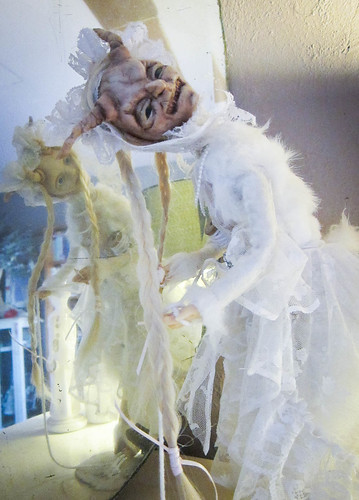
Perchta – Derived from an early Germanic word meaning “bright or “glorious”. Perchta is famed for her dual nature. Her grim aspect is known as “Perchta the Belly Slitter”. Perchta is alternately described as kind or violent, as a monstrous hag or a willowy maiden.

Perchta is typically veiled and clothed in white and is often portrayed with the horns, shaggy fur and hooves of a goat. The Medieval Church wrote of “sinners” who would leave food for Perchta in the “Night of Perchta” to obtain prosperity and well being in the coming year, as well as commanding the people to surrender their belief in “Frawen Percht”, and complaining of locals who would rather chant of “Domina Perchta” than say their prayers to the Virgin Mary.
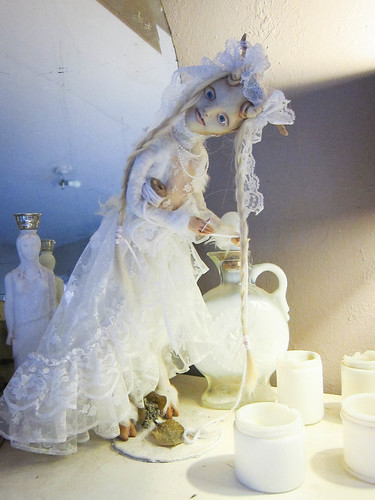

Perchta is associated with the spindle and with spinning. When the shepherds brought flax to her in the summer, she blessed their flocks, and they would often see her walking along the steepest slopes around twilight, with a golden spindle in her hand. The spindle is strongly associated with fate and fortune and is central to traditions of girls’ puberty initiations. Perchta oversees the timely completion of the season’s spinning – if you don’t get it done on time, Perchta might curse you with bad luck in the next year, or even cut open your stomach, pull out your entrails, and refill you with rubbish!
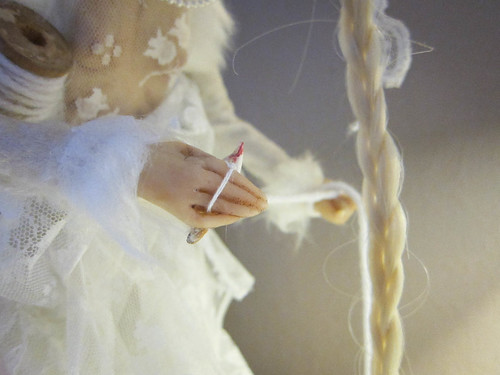
Perchta is associated with the Wild Hunt in folklore and is often said to be the one leading it. The Wild Hunt is held by the Forest Gods in the deep winter months, and may be dangerous to humans; being in the path of it can be deadly. Perchta’s victims are typically portrayed with their bowels trailing behind them. This symbolic evisceration implies a profound examination of the self.
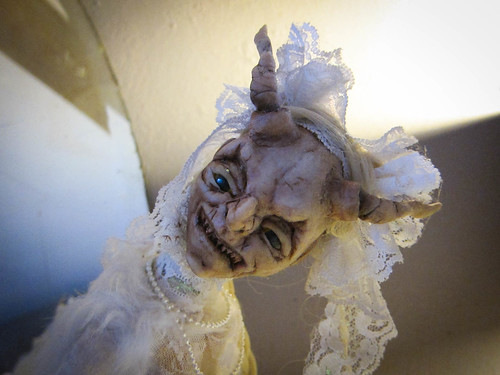
Perchta is a major figure in the winter holidays throughout the alpine world. She is widely held to be the female counterpart to the devilish Krampus, and will often accompany him on his hunt for naughty children on December 5th. Perchta is particularly associated with Epiphany, starting the night of January 5th and going on to January 6th. This holiday is sometimes referred to as “Perchtentag”, meaning Bright Day, Perchta’s Day, or Perchten’s Day.

“Perchtenlauf is an ancient Pre-Christian ritual where young men dress in costumes with frightening “Perchta masks” going from house to house frightening away the evil spirits of Winter that wander the countryside seeking to harm humans. This procession was traditionally done on the winter solstice. This is the longest night of the year where the sun shines the least. It is also the beginning of when the Sun begins its return trip and shines for longer periods bringing the warmth of Spring. Perchta was summoned on this night to frighten away the long cold winter and make room for the brightness of spring. Hundreds of years ago when the threat of death during the cold winter months was very real for the Teutonic tribes people, it was necessary for people to be given hope of the coming spring. Perchta was the goddess who fought back against the darkness of winter not only in the external world but in the hearts of humans. The ritual of Perchtenlauf no doubt has roots extending into pre-historic ice age shamanic rituals of the proto-Teutonic people. Surprisingly, the ritual of Perchtenlauf has been continuously practiced in the Alps up until the present.
Perchta shows dual faces at this time. To the faithful, she appears as a beautiful goddess of light who blesses humans with health and prosperity. To the evil hearted, deceitful and wicked, she appears as a ferocious demon with horns and fangs. In this depiction, she is strikingly similar to the east Indian goddess Durga who alternately appears as the nurturing mother of all and the frightening Kali Ma who devours demons and drinks their blood.”
– From Perchta: Protective Goddess of Light and Dark by Thunderwizard
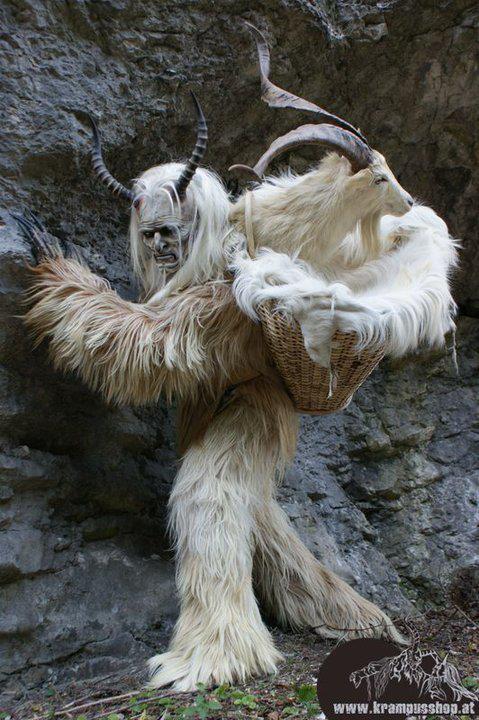
…”the Krampus was believed by alpine Germans and Austrians to accompany Saint Nicholas on his rounds, but rather than just stuffing lumps of coal in a naughty child’s stocking, the Krampus – who, by the way, was depicted as a very tall, very shaggy, goat-like man — would inflict corporal punishment on the boy or girl with a cluster of sticks. If the child was particularly naughty, he or she would simply be thrust into a basket and taken away, one supposes, to whatever horrible place the creature came from — a place we can be quite sure was not Christmastown. Such a fate must have been one of the more effective threats leveled on a badly-behaved medieval child by his angry parents. Better than the ‘no presents’ approach, certainly. (Although in fairness, one must wonder exactly what presents a poor village child would have been expecting. Perhaps imagining terrible punishment from an other-worldly goat creature, and the avoiding of the same through good behaviour, was simply a natural anthropological response to having no upside at Christmas.)
Unfortunately, surviving the time of the Krampus would not get your family off the hook for the season, for it was also believed that during the twelve days following Christmas, a goddess would make her rounds of the countryside, inspecting homes and spinning rooms for any signs of disorder or laziness. This was, to the northern Germans, Frau Holda, an almost entirely benevolent divine being who taught humans the household arts of spinning, weaving, and reaping, but who was no softy: she was believed to ride with Wotan’s ghostly army (into which host the spirits of unbaptized infants were incorporated when they died), and was fond of setting on fire the spinning distaffs of any girls she thought had been unproductive and slothful that year.
Frau Holda‘s wrath, however, was mild compared with that of Perchta, the south German variant of the same goddess. On her festival day, she expected celebrants to eat only fish and gruel, which was considered fasting fare. The penalty for failing to do so, wrote Jacob Grimm in his Teutonic Myths, was ghastly: ‘whoever has partaken of other food on her day, she cuts his belly open, fills it with chopped straw, and sews up the gash with a ploughshare for a needle and an iron chain by way of thread’. In Swabia, her role was believed to similar to that of the Krampus – though more lethal — as ‘with hair all shaggy she walks round the houses at night, and tears the bad boys to pieces.’”
– From In the bleak midwinter, an excellent article by I. Garrick Mason at sans everything
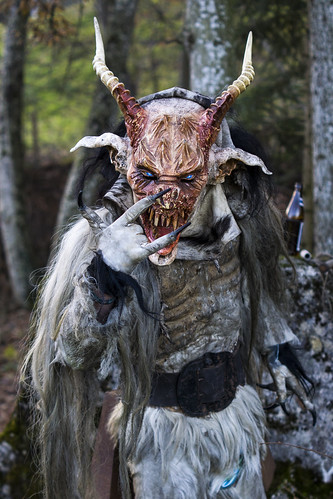
By s.stegh

From CRUSHEVIL:
Masked figures from the ‘Wilde Jagd’ Christmas folklore festivity in Salzburg, Austria. These festivities originate through the Perchtenlaufen custom, a period when the fearsome witch Perchta, who envies happily married couples, roams the villages. Processions of horribly masked figures armed with sticks and clubs meet throughout the festivity to chase the witch away.”
This picture is from Masks, Face Coverings and headgear by Norman Laliberté and Alex Mogelon
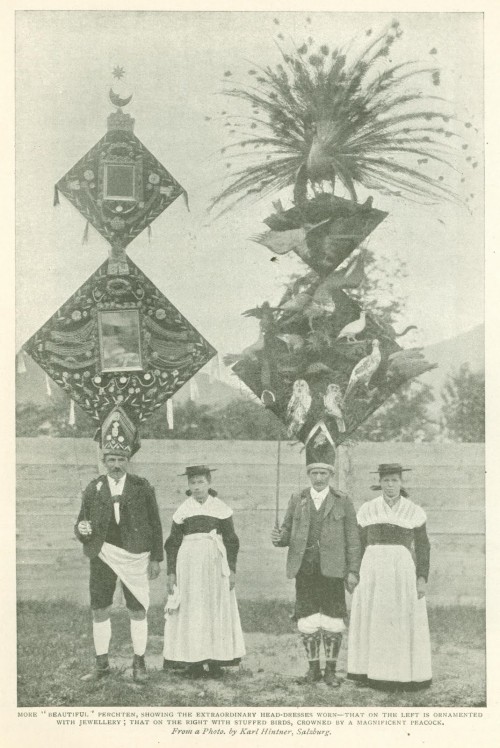
These headdresses are maybe the most captivating examples of folk ritual costume I have seen – in a long time. I would love to see them in person, in color. There’s got to be some crazy alpine museum in the mountains where some of them still exist, wouldn’t you think? I must find this place.
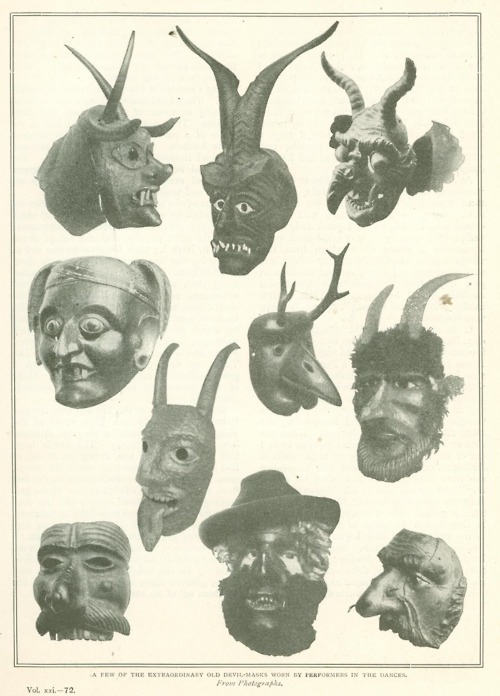
Some of the masks worn by Perchten Dancers of Salzburg.
I discovered this amazing article via the marvelous digital history project. It was originally published in the Wide World Magazine, September 1908. I’m reposting an excerpt here, but the whole thing really is just too fascinating, so please do go read all about it.
The Perchten Dancers of Salzburg Austria Tyrol Pinzgau
By MRS. HERBERT VIVIAN.
Amongst the mountains of the little Austrian Duchy of Salzburg dwell peasants who still mingle religion and mythology in a curious jumble and observe many remarkable customs. Perhaps the most extraordinary of their festivals is the Perchten dance, which is performed only at very infrequent intervals. Mrs. Vivian was fortunate enough to witness the latest celebration of this unique function and secure a set of striking photographs.
The Perchtentanz is named in honor of Perchta, another name for Holda or Freya, Woden’s consort and the mother of the gods. Although banished from many of her ancient haunts by rude civilization and unbelief she still clings to Salzburg and parts of the Tyrol, where the peasants not only believe in her, but fear her. Perchta means the Splendid, the Magnificent One. She may be seen, they say, wandering through the great fortress of Salzburg at dead of night. Towards the beginning of the year, in the guise of a tiny, wizened witch, with gleaming eyes, long hooked nose, and wildly tangled hair, she lurks at crossroads, waiting for travelers. When one approaches she greets him, with her friendliest smile, and holds out to him a black cloth. If he takes it he is done for, and will certainly not survive the year; but if he brings out his crucifix and says, “Dame Percht, Dame Percht, throw the cloth on the earth,” then every joy and blessing will come to his house.
If Perchta shows herself in a stable, sickness and death are sure to follow, unless the careful peasant hangs up a bunch of consecrated St. John’s wort, a potent herb in these lands. On other occasions the goddess gathers all the un-baptized children round her, and sweeps through the country at the head of the band. At Christmastime a spoonful of every dish used to be placed on a fence, or a gate, outside the house as an offering to this much dreaded lady. One of the strangest things about Perchta is that she has a double nature. Sometimes she is the soul of goodness and charity, at other times she is full of hate and malice to mankind. Men are fascinated by her, but their feelings are mixed, and fear is mingled with longing fear on account of her un-canniness, and longing because of her wondrous powers.
Perchta has her troops of followers, strange beings half-way between mortals and immortals, These do not live among the children of men, but appear amongst them at such times as Advent and the Feast of the Three Kings. Like Perchta herself, they are divided in disposition, for some are good, kindly creatures, such as the “beautiful” Perchten (Schiin Perchten); while. others, like the Schiachen Perchten, are wild, irresponsible, malicious things. They are more felt and heard than seen. In swarms they come down on men’s dwellings, and are recognized by their weird screams and laughter. They love to draw men into danger by alluring sounds and spells, and to punish undiscovered crimes. The Perchten dances originated among the peasants of the mountains, who desired to imitate these mythological beings, but of late years the performances have seldom been seen.
Presently there was a stir. The “beautiful” Perchten were arriving. Nothing could. be more fantastic than the appearance of these gentlemen. The pictures describe them far better than any words of mine can do. The lower part of their costume is unobtrusive, and all one’s attention is centered on their heads, which are crowned with what surely must be the most immense and eccentric head dress in the whole world. Two diamond. shaped boards, in all some ten or twelve feet high, are covered with red velvet. On them are fixed dozens of silver watches and chains and every kind of ornament the Perchten have been able to collect or borrow – looking glasses, artificial flowers, pictures of the Virgin, bracelets, necklaces, and coins. At the top comes a crown, above that a moon, and then again a star.
In their right hands the “beautiful” Perchten clasp a naked sword, and with the other they lead their partners – young men dressed as women. The latter were disguised so skillfully that it was almost impossible to tell whether they were really women or not, for of course there were many wives and daughters of the Perchten helping with the preparations. I remarked on this to my guide, so he immediately seized hold of the first person in woman’s garb he saw, and inquired:
“The English lady wants to know if you are a man or woman. Now, let’s hear which you really are.” As a matter of fact, the victim was a very shy girl; and there were blushes and giggles, accompanied by squeals of delight from the crowd.
The noblest of the “beautiful” Perchten wear bird head dresses. These are large pieces of moss covered board, and on them are fixed every rare bird that has been shot in the neighborhood by the Perchten and their friends. The “tafel,” as they are called, are really most striking and artistic. On the top comes a large bird with outspread wings, in this case a huge peacock with a gigantic tail. Naturally these head dresses are of a terrific weight; and have to be supported and steadied by an iron rod which is fastened to the back at the waist. I should think the poor fellows suffer for being beautiful, as the strain and the heavy load must conduce to violent headache. The back of the erection is usually covered with canvas and painted with a pastoral scene, such as the Almfahrt. A good part of the toilette of the Perchten had to be done in public, and it was rather amusing to see their wives fussing round them doing up buttons and tying strings.
This song isn’t really related to Perchta, and is Finnish rather than German, but I’ve become obsessed with learning it, and have been playing this entire album all through the winter holidays. It was only recently that I discovered the meaning of the lyrics, which are quite bleak. I love how happy and lilting this little lullaby is, only to have its deeper meaning revealed – if you can understand Finnish… A dual natured kantele seems fitting for Frau Perchta.
Eriskummainen kantele (The bizarre kantele)
Ne varsin valehtelevat, (Those indeed tell lies)
tuiki tyhjeä panevat, (are saying just empty words)
jotka soittoa sanovat, (those who judge the playing)
arvoavat kanteletta (claiming the kantele)
Väinämöisen veistämäksi, (being crafted by Väinämöinen)
Jumalan kuvoamaksi, (woven by the God)
hauin suuren hartioista, (out of a great pike’s shoulders)
veen koiran koukkuluista. (from the crooked bones of a water dog)
Soitto on suruista tehty, (But no, music is made from grief)
murehista muovaeltu: (and moulded from sorrow)
koppa päivistä kovista, (– its belly out of hard days)
emäpuu ikipoloista, (its soundboard from endless woes)
kielet kiusoista kerätty, (its strings gathered from torments)
naulat muista vastuksista. (and its pegs from other ills.)
Sentä ei soita kanteleeni, (Therefore my kantele will not play)
ei iloitse ensinkänä, (nor will rejoice at all)
soitto ei soita suosioksi, (music will not play to please)
laske ei laatuista iloa, (give off the right sort of joy)
kun on huolista kuvattu, (for it was fashioned from worries)
murehista muovaeltu. (moulded from sorrow)

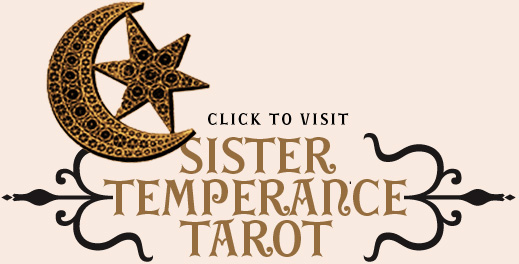
3 comments
Wow! I really enjoyed this. Very inspiring. Thank you for sharing. XOXOX
by Carley on January 8, 2013 at 9:19 am. #
I was Perchta for Halloween this year, on Pandora’s suggestion!!! Children, especially, loved it, because at first they said, “you are beautiful!!!” and then, when I turned around they all shrieked!!! One lady I met asked me if I was a real fairy….I still don’t know if I answered that question correctly. Pandora’s doll is beautiful beautiful!!! This year’s costume really made me think about all of our faerie creatures and inspirations, and strive to be more in touch with them. I am now in the beginning of a very deep winter: I wish you could see it and feel it. It is very different here now. xoxo
by Patience on January 8, 2013 at 7:35 pm. #
I really appreciate this information. It makes me miss my family and long for the old days of the ancestors. This is as close as I get to their experience.
by John Rauch on December 22, 2013 at 10:02 am. #